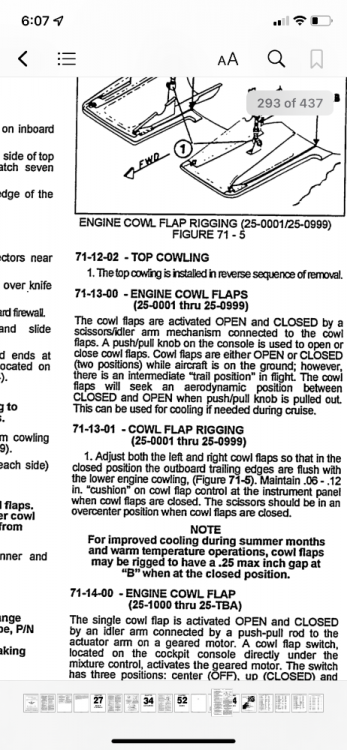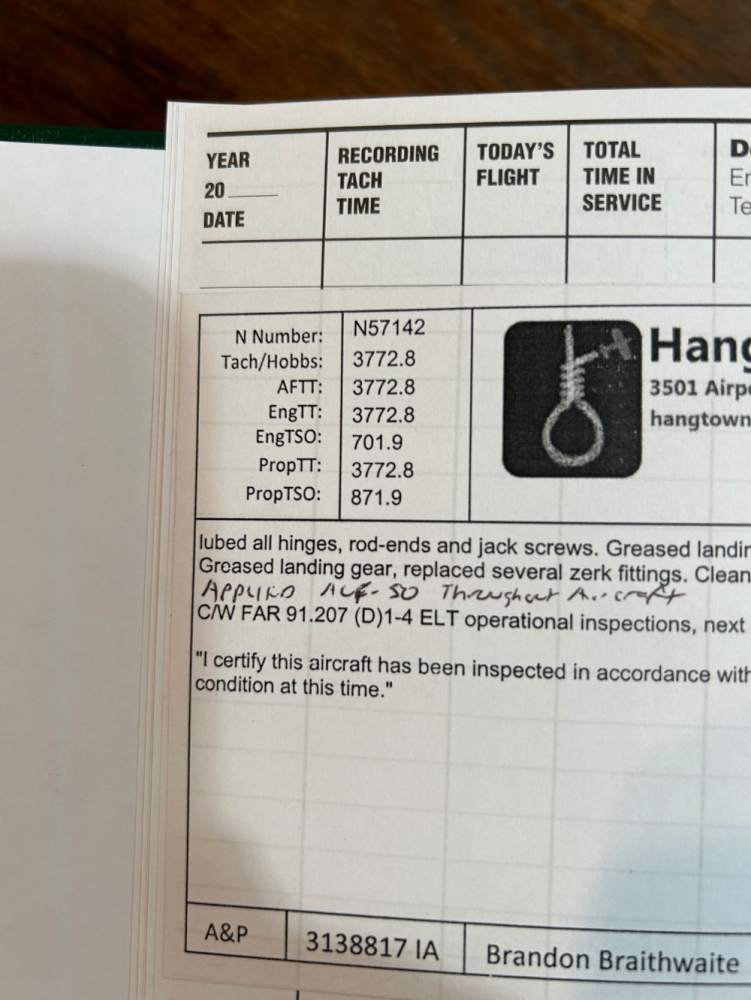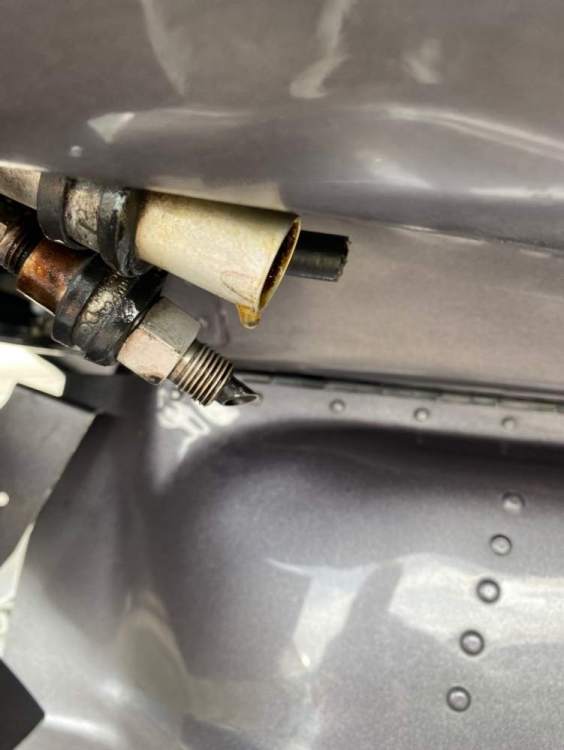
jrwilson
-
Posts
840 -
Joined
-
Last visited
Content Type
Profiles
Forums
Blogs
Gallery
Downloads
Media Demo
Events
Posts posted by jrwilson
-
-
17 hours ago, Steve Dawson said:
How much are you looking to see it for?
I was thinking $1000 plus shipping, though I really don’t want to ship it.
-
-
12 hours ago, gabez said:
Hello,
I did some research last night and trying to get some more guidance around full power climb. When I had by V tail the manual asked for reduce power during climb but everyone said to go full power (which indeed kept the engine cooler)
I read through this forum that the message is the same, basically in the 80s they had a different idea round engine management and as long as the CHT are below 400-380 full power climb is okay.
My question is that on the Marlin supplement I think it says Full power only for 5 minutes. Any suggestions and/or thoughts? I usually take off 40' and 2700 and then back it to 33' 2600.Thank you
Do you have an intercooler? If so, you should dial that take-off MP down a bit. If no intercooler, disregard.
-
On 11/19/2023 at 10:34 AM, tracer773 said:
I said FIKI, and would prefer FIKI, but would be ok with inadvertent TKS. I don't have the illusion of intentionally flying in icing conditions but I have been in 'helpless' situations before and don't like the feeling. Having a turbo that can potentially climb out and TKS to give me the time to do so would likely be good enough.
My budget is likely going to be $300k for purchase price plus first year squawks. Which sounds like it will be doable but I will need to jump on the right opportunity quickly.
I noticed this one but had concerns about the ability of a single alternator to keep up. The 231 or a 305 would likely fit my needs, even with load restrictions. But I would want to modernize the panel and it seems like the system would be easily overloaded.
I have the single alternator 12 V system on my 231. Does fine with an electrical load w LED lights. Only issue is on the ground or on short final when power is pulled way back.
-
I just bought a new prop for a 231 from tiffin aire in Ohio. Way less than McCauley retail and less than any other place. Plus they were fast. Shipping was even reasonable. I was getting prices for overhaul and prices were all over the place, but pretty high. A new prop was within $1500 of the expected overhaul price.
-
 2
2
-
-
You could use Mather also
-
 1
1
-
-
2 hours ago, Pinecone said:
James sells Whelen lights and hangs out here.
My M20K is getting the combined LED strobe and nav light. Orion 650E. And getting the Orion 500 for the tail, so it will be strobe and nav also.
Any other options other than the Orion?
-
-
I think the critical altitude is 24,000 with the Merlyn. I'm not sure if that is with the combination of Merlyn and Intercooler, which is what I have. But the Merlyn install claims it gives critical altitude all the way to 24,000. I've confirmed it will do it.
-
 1
1
-
-
4 minutes ago, Fly Boomer said:
Any convictions?
Many. Always gets reduced, but the DA does pursue it.
-
 1
1
-
-
4 hours ago, mhrivnak said:
The limiting factor is the ability to find the person with the laser. The position report given by a pilot is likely to be "at my 2 o'clock in 1 mile", which is highly imprecise already. Then ATC has to figure out how to translate that into a location that law enforcement can use. Unless the pilot is willing to circle and spend time identifying a specific location, which may or may not even be possible depending on how urban or rural the location is, little can be done.
Green lasers can cause permanent eye damage, so don't spend time looking for the source unless you happen to have protective eyeware.
Episode 142 of the Opposing Bases podcast (highly recommended as a podcast) talks about the ATC side of how difficult it is to do anything about green laser events.
If able, check foreflight/Garmin Pilot traffic display and see if there is a law enforcement aircraft nearby and give them a call on the radio. They often do have protective eyewear and can go track the laser source.
-
I get hit a lot since I do a lot of circling over cities at night for work. I have a camera on the plane, so I can give a pretty good location for law enforcement to go. In California it is a felony and law enforcement takes it pretty seriously. When I get hit and I'm out of my normal area, I check foreflight and find the nearest law enforcement helicopter and send them over to coordinate a ground response. Works pretty well.
-
 1
1
-
-
Not positive, but doesn't the GB not have the adjustment screw? Don't you have to add washers to the spring to increase pressure?
-
I had three broken Cotter pins, same type of engine, after overhaul. Found in screen. Mechanic said they were improperly installed “not peened” and it was hard to tell but he thought they might have been slightly too small also. Engine shop covered most of the repair, except my California mechanic was more expensive than the overhaul shop covered so I was out a few thousand…
-
1 hour ago, A64Pilot said:
I’m at a loss to explain it, did you just change oil? I ask as that pic looks like very fresh oil
Smell the oil, does it smell like fuel?
To be honest I’m reaching at straws here, and by posting that brings your post to the top of the list for more to see too, maybe someone else knows the answer. I’ve seen things like excessive blow by overheat oil etc, but I’ve not seen high oil temp come and go with altitude.
Initially I was thinking you were running the snot out of it, and the engine was running hot, but not with those cyl head temps.
Oil had about 16 hours on it at that point. Smells fine.
I appreciate the post bumps

-
2 hours ago, A64Pilot said:
There is no probe on the vernatherm that will freeze so that’s not it. Could possibly be a bad vernatherm but I don’t think so, when they go, they aren’t usually intermittent, a bad vetnatherm usually shows up in the climb where oil temps are usually higher due to high power and lower than cruise air speeds, clogged oil coolers the same
What were your cylinder head temps during the high oil temps, and did they change any? Were they higher too? We’re you LOP or ROP and by how much?
Watery oil looks like a milkshake, cloudy, milky, sometimes yellowish, but not clear. What you have looks like good fresh clean oil, but then I’m on an Ipad
Is it possible that you were running it very hard?
Cht was 330 ish with no change during the issue. Oil wasn’t milky on the dipstick either. Looked clean. I was rop by a little less than 100.
not running hard. 2450/26”
-
7 minutes ago, jrwilson said:
Hoping for some ideas on a cause.
m20k 231 w intercooler and Merlyn. using 100w plus oil
On the way back from Washington, about 2 hours in at 12,000’ the oil temp started to creep up while the pressure dropped. Topped out at about 190 degrees on jpi and pressure dropped to 31, top of yellow arc. OAT was 8 to 10 deg F. Had gone through some clouds for a bit prior to incident. Didn’t pick up any ice on wing. Diverted to Medford.
during descent, about 10,000 feet and 20 deg F OAT pressure came back up and temps dropped back down. CHTs we’re fine/TIT was fine. Engine ran well. On the ground there were no oil leaks on the plane and nothing dripping from turbo. No apparent oil loss on dipstick. Oil out the breather felt like water. On the ground looked like water drops below breather. Called mechanic he thought a temp probe froze causing possible vernatherm issue.
tried again, climbed to 12,000’, ran great, pressure 49 and temp 160 during climb. Cylinders and TIT fine. Went through a couple of clouds (no ice on wings) OAT was about 12 F. Same thing started happening, temp going up and pressure down, still maybe 190 and top of yellow arc before I started doing something. Descended through 9,000’ and 20f OAT and it remedied again. Stayed low at 6,000 and finished flight. Temps at 160 and oil pressure at 49-50 psi. Cowl flaps closed.
landed and still no leaks and no oil consumption. Watery oil dripping from breather.
did the flight up to Washington two days earlier w no issues. Flew higher at 16,000 to 21,000’ and OATs at 0 deg f. It was cloudy but I dodged those because they were very convective and didn’t get into clouds until descent and below 10,000’
another possible factor was the day before I flew a very short hop from one island to the other for gas. So not good for moisture in oil. Also it rained the night before.
any ideas would be appreciated! Thanks.
-
Hoping for some ideas on a cause.
m20k 231 w intercooler and Merlyn. using 100w plus oil
On the way back from Washington, about 2 hours in at 12,000’ the oil temp started to creep up while the pressure dropped. Topped out at about 190 degrees on jpi and pressure dropped to 31, top of yellow arc. OAT was 8 to 10 deg F. Had gone through some clouds for a bit prior to incident. Didn’t pick up any ice on wing. Diverted to Medford.
during descent, about 10,000 feet and 20 deg F OAT pressure came back up and temps dropped back down. CHTs we’re fine/TIT was fine. Engine ran well. On the ground there were no oil leaks on the plane and nothing dripping from turbo. No apparent oil loss on dipstick. Oil out the breather felt like water. On the ground looked like water drops below breather. Called mechanic he thought a temp probe froze causing possible vernatherm issue.
tried again, climbed to 12,000’, ran great, pressure 49 and temp 160 during climb. Cylinders and TIT fine. Went through a couple of clouds (no ice on wings) OAT was about 12 F. Same thing started happening, temp going up and pressure down, still maybe 190 and top of yellow arc before I started doing something. Descended through 9,000’ and 20f OAT and it remedied again. Stayed low at 6,000 and finished flight. Temps at 160 and oil pressure at 49-50 psi. Cowl flaps closed.
landed and still no leaks and no oil consumption. Watery oil dripping from breather.
did the flight up to Washington two days earlier w no issues. Flew higher at 16,000 to 21,000’ and OATs at 0 deg f. It was cloudy but I dodged those because they were very convective and didn’t get into clouds until descent and below 10,000’
another possible factor was the day before I flew a very short hop from one island to the other for gas. So not good for moisture in oil. Also it rained the night before.
any ideas would be appreciated! Thanks.
-
On 4/20/2022 at 7:30 PM, T. Peterson said:
Good evening all,
I recently purchased a 1979 K model. I have noticed that in the fully closed position the cowl flaps are not flush with the fuselage but still droop about one inch. I called the previous owner to ask if he had the flaps rigged that way to provide better cooling, but he said he had not done so and didn’t realize they were so rigged.
I am tempted to have my mechanic rig them flush, but am not sure that is wise. Is it possible that this one inch droop is factory set and should not be disturbed? I welcome your informed insight.
Torrey
 So looks like flush is the factory setting for closed position according to the service manual. With an allowable .25” gap for warm weather
So looks like flush is the factory setting for closed position according to the service manual. With an allowable .25” gap for warm weather
-
 1
1
-
-
20 hours ago, T. Peterson said:
I have not had a problem with over-temp, but that may very well be due to the droop. Also hot summer has not yet arrived. Furthermore, since I am brand new to GA and piston airplanes, I am trying to be very conservative. I can’t get any better than about 12.4 gph at any altitude from 6000 to 13000 feet. My TIT is about 1550 and cylinder temp 340 to 380. The belly of the airplane is filthy, but that is going to be remedied on the 28th. I thought that maybe the dirt and cowl flaps were costing me, but I guess not. TAS runs between 157 and 162.
The former owner said he got 11 gph at 11000, and I suppose if I pulled MP back I could do better. I cruise at 2500 rpm and 28 inches.Power settings sound good. I do slightly higher for fuel burn, at 12.7 and don't go over 350 in cruise for CHT with about the same TIT.
-
13 hours ago, T. Peterson said:
Good evening all,
I recently purchased a 1979 K model. I have noticed that in the fully closed position the cowl flaps are not flush with the fuselage but still droop about one inch. I called the previous owner to ask if he had the flaps rigged that way to provide better cooling, but he said he had not done so and didn’t realize they were so rigged.
I am tempted to have my mechanic rig them flush, but am not sure that is wise. Is it possible that this one inch droop is factory set and should not be disturbed? I welcome your informed insight.
Torrey
BTW, that's a fun, aggressive N#

-
 1
1
-
-
Mine are flush when closed and it is a fairly easy adjustment. How are your temps when they're closed? Do you think you need them open a little? Is it helpful? With your model, you only have three cowl flap settings, "Closed", "Trail" which is about half open and full open. If my cowl flaps are fully closed, depending on OAT, my CHT's and oil temp will gradually creep up so I have to open them to Trail. So maybe a little droop is a good thing, depending on your temps.
-
On 1/30/2022 at 9:12 AM, Cruiser73 said:
Sorry for responding to an older post and I was hoping to "hijack" the thread for a minute. I am a new owner to a Mooney M20G and I don't have a mechanic yet. I have an minor issue would like to have checked by an A&P. My home airport is KSAC so I was hoping some of the local Mooney Drivers ( @Smith813 @201Mooniac @Jetrn@thinwing @spectre6573 @Joe Larussa @mech_IFR @RobertGary1 @Flash ) could chime in and recommend a few A&Ps that they trust? I have heard about LASAR and Top Gun just wondered if might be some more options. Thanks
I like hangtown aviation in Placerville
-
 1
1
-
-
No it was sold






M20K IPC manual
in General Mooney Talk
Posted
“Illustrated parts catalogue”. I had to look it up…maybe I was having a stupid day though :)